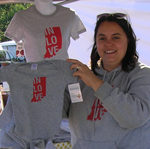Cartoons: We’ve Got Company
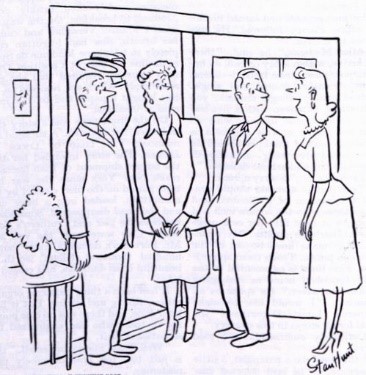
July 2, 1949
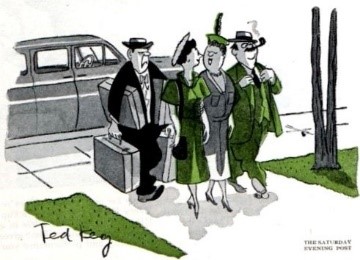
August 6, 1949

November 18, 1950
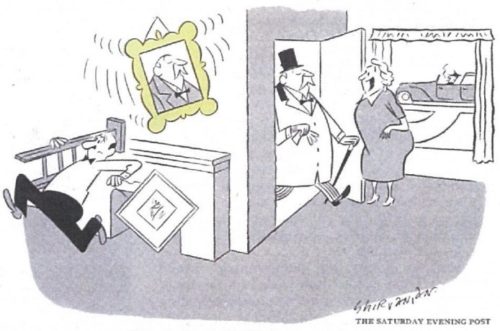
October 2, 1954

April 18, 1959
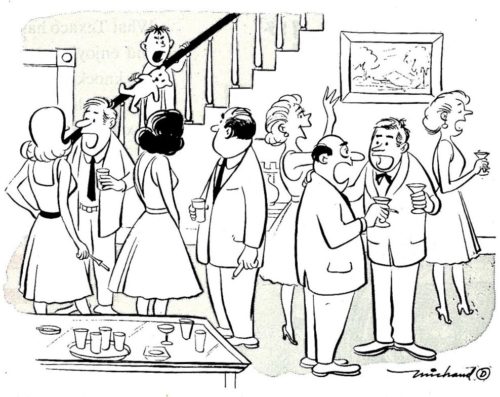
November 29, 1959

April 29, 1961

October 1982
Haunted by an Ugly Name
My name is Jane. That’s what I’ve been called for nearly 50 years. Mom or Mommy to my daughters, Janie to a couple of old friends. Otherwise it’s Jane. When I look at myself in the mirror, Jane looks back. Sometimes when I see my reflection I think, oh my, when did that happen? But I recognize the person looking back. That’s me. Jane.
At birth, 66 years before the story I’m about to tell, I was Martha Jane. But so many years had passed since I’d excised that despised first name that I rarely thought about it. Then early one August evening in 2015, while gathering the documents I needed for a bank loan, I went online to get a copy of a pay slip from the university that employed me.
A new system had been put into place so employees could easily access all of their information. There I was: Jane Bernstein. Of course. I’d been hired as Jane, married and divorced as Jane.
Jane Bernstein was on my daughters’ birth certificates, on my driver’s license and passport. Only Social Security sent letters to Martha Jane, and they didn’t seem confused that elsewhere I was Jane.
Now, though, I paused. Years earlier, while applying for a mortgage, the process had been held up because of a bill for $25 that had gone to a collection agency. This time I wanted the loan to be approved without any snags. Better make sure everything matches up perfectly, I thought. So I entered a change on the university website: Jane to Martha Jane. In the comment section, I briefly explained my long, comfortable, well-documented history as Jane. Then I logged off.
The next morning, I got an email response. To: Martha Bernstein. It was unsettling to see this name in print. I felt as if a ghost had risen.
When I went back online, the system wouldn’t let me retract what I had written the night before. Neither would the woman in human resources who answered the phone.
No, she said. I couldn’t restore what had been on file before. There were new IRS laws. New Social Security regulations. The university had to comply with them. It didn’t matter that in the past I’d been allowed to use Jane without legally changing my name. It was no longer possible. Henceforth, in all correspondence of every sort, written and electronic, I would be Martha Bernstein. I pointed out that I’d been hired by the university in 1991 as Jane Bernstein. “No one knows me as Martha Bernstein,” I said. “I don’t even know me as Martha Bernstein. I’ve never used it here. Not one time. Wouldn’t it seem a little strange if suddenly, apropos of nothing, I was called by another name?”
The woman in human resources repeated what she had said before. She was sorry. “Do you want to speak to my supervisor? She’ll be in the office later this afternoon.”
My voice was trembling. “Yes, I want to speak to your supervisor.”
I went outside. The tide was low and cormorants were lined up on the granite ledge. I was in Maine, standing in what to me was the most beautiful place on Earth. I was fine, my loved ones were fine. I had reached an age when I knew what truly mattered. Get a grip, I told myself. Stop crying over nothing. I could hear the voice of my long-dead mother telling me that. I agreed with her, or wanted to at least.
I knew what I could say to the supervisor if she told me nothing could be done. My sister was murdered — stabbed to death by a stranger — when I was 17, and I hadn’t used Martha since then. When I went to college a year after the murder, I left my name behind, as if that way I could shed my grief. But that was years after the heated, impossible-to-explain prior relationship with my name. Fourteen years, according to my mother. I was four when I told her there were light names and dark names, and Martha was dark. When she related what to her was a cute anecdote, I thought: Yes, that’s exactly right. Four years old and I knew that the name I was called was “dark,” wrong, ugly, not me.
Why? I recall nothing traumatic from those years when my family lived in a suburban garden apartment. I had two parents, a sister, canaries, tropical fish, a soulful, obedient dog. I was cute enough, bright enough, hardly friendless, and yet to say I hated Martha doesn’t capture how I felt when someone said my name. It made me squirm, filled me with shame. I’m not a Martha, I always thought, as if I was being labeled something foul-smelling, dark as sludge. A Martha. Something ugly I needed to cast off.
In elementary school, I tried hard to be called other names — Jinx and Lefty were the first futile attempts, then Patty and Matty, after I’d read they were diminutives for Martha. I inked these nicknames onto the canvas cover of my ring binder, wrote them in fancy script on notes to friends, announced my name change at breakfast. Nothing stuck. It was as if I was a Martha, no matter how much I protested.
The desire to be free of this dark, wrong, hated name grew. And then my sister’s murder, which ripped apart my family. Less than a year later, right before I left for college, I announced that, henceforth, I would only answer to Jane. I don’t remember making a decision to use my middle name, only that the moment I said “Jane” aloud, I knew it was right. I gave my friends and family no time to adapt. I was furious if someone slipped, or when I heard someone whisper that my real name was Martha.
Colleges are filled with kids who seize the chance to alter their hair color or image or name. It is, after all, a time when they get to make their own decisions, and a place where they are not yet known. I wonder how many rush up to their instructors on the first day of class, as I did, desperate to stop them before they called out the names on the rosters. But apart from these tense moments, I simply was Jane — to everyone I met. To myself. With Martha gone, so too was the ugly thing the name summoned from within me.
Years passed and my life began to fill with people who never knew there’d once been a Martha. It took until I was in my 40s before I’d tell a close friend that Jane had been my middle name. By then, I’d met many people who were no longer called by their birth names. I met other Marthas, too. What a nice name for you, I often thought, for I’d come to realize I didn’t dislike the name itself. Sometimes one of these Marthas would ask, “Did you legally change your name?” But why would I need to do that when I already was Jane, inside and out?
As a memoirist, I’ve unearthed much of my history. Though I never understood the extreme response I had to my first name at such a young age, the dreadful discomfort remains vivid. It was as if Martha was not my true gender, not the self at the age of four I demanded, without success, my parents see. I knew what I was — it was the label that pained me deeply.
Nearly 50 years had passed since I’d written that name as my own. Not me, I thought, as I filled in the boxes, one letter at a time. It still felt as if I’d been forced to swallow something bitter.
The supervisor from human resources called later that afternoon and said she was sorry, but nothing could be done.
In the end, it wasn’t really an impossible problem. The next day, the young woman in human resources who first took my call contacted Social Security and learned I was on record as both Martha and Jane. “Case # INQ0037979 resolved” said the subject header on an email sent to: Jane Bernstein.
Then it was as if none of this had happened. I went back to worrying about the refugee crisis, my daughter’s wellbeing in Eastern Europe, the syllabus I had yet to plan, the sentences in my manuscript, what I might make for dinner. In short, I was back to being Jane.
Right away the name thing began to feel trivial, but the depth of my distress continued to trouble me, and I found myself wondering if something awful had happened when I was young. For a while I looked for shadows, for some evidence of the harm that had been done to me by the incident or by repressing it. All I found was the name, and what was unearthed when I was called it.
Maybe my name is like the tumor on my spine that was detected by an MRI after a sports injury. What anxiety I’d felt in the days between the MRI and the results of a second diagnostic test.
What awful scenarios I’d imagined while I perched on the end of the exam table and waited for the news.
“The tumor?” said the doctor offhandedly. “You can forget about it. It’s just something you were born with.”
Jane Bernstein is the author of five books, including the memoirs Bereft — A Sister’s Story and Rachel in the World. Her essays have appeared in The New York Times Magazine and The Sun, among other publications. She is a professor of English at Carnegie Mellon University.
From Craft Consumer to Craft Vendor
As a craft dabbler, I love summer craft shows. I enjoy not only buying crafts (although that’s always fun), but also getting craft ideas. And, briefly, after every craft fair, I wonder, “Could I profit from my own adventures in crafting?”
Apparently I’m not the only one asking this question! Many craft-show attendees voice these thoughts, says Martha Latta, who has participated in over 73 craft shows in the past three years. “Sometimes, they’ll just walk up to you and say, ‘I want to set up my booth here. Where do I sign up?'”
And, although supportive of these newbies, she also finds the question frustrating. “It’s just not that simple,” she explains.
Martha has been crafting professionally under the moniker Sunday Afternoon Housewife for four years. Her clothing, jewelry, and magnets are sold in craft fairs, online, and in 19 different U.S. shops—from Massachusetts to Texas. A part-time teacher at Ivy Tech Community College in Indianapolis, Indiana, she’s no stranger to helping people learn new things. So, here are Martha’s well-practiced tips to go from craft consumer to craft vendor.
Martha’s Craft Vending Tips
Know Your Shows.
There’s a big difference between juried and non-juried shows. Juried shows are generally larger, nationally renowned, and will not accept walk-ins. “Usually, you have to fill out an application three to five months in advance,” says Martha.
To find application dates for juried shows:
- Check their website at least five months before the show.
- Sign up for their e-newsletter.
- Follow them on Facebook. (Martha advises that this is the best way.)
The non-juried craft shows are generally first-come, first-serve. “Some you could email a week before [the show] and still get in.”
For beginners, Martha suggests attending a few non-juried shows. But do your research, she warns. “You have to ask, what do you want to surround yourself with? At non-juried shows there are a lot of hobbyists. And Tupperware and Mary Kay. And wholesale stuff; it might be handmade, but probably in China. You can’t compete with wholesale prices.”
Before jumping into any old craft show, it might be a good idea to ask around—unless you want to compete with thousands of 99-cent lilac sachets or machine-made plastic tubs.
Get Organized.
Martha’s an expert in scheduling. In 2004, Sunday Afternoon Housewife began as a self-published zine. It was dedicated to band interviews and local show times. So, even then, Martha was honing her planning and scheduling skills. Now she keeps all the dates for her upcoming craft shows in a calendar.
What to include on your calendar:
- Application deadlines
- Acceptance dates for shows
- Show set-up and tear-down times
- Dates of shows in which you’ll be participating
Start Crafting.
- Find one craft you can do quickly.
- Master it.
- Make as many as you can.
When asked about her first show, Martha just laughs. “The weather was terrible,” she says. “We weren’t prepared. We had an awkward mix of crafts, and we ran out. That’s when I realized I needed to find one craft I wanted to do, and stick with it. I don’t make money off of knit and crochet—I’m too slow. One girl I know can knit a hat in an hour! That’s not me.”
Martha is author of the e-book, The Blogging Adventure: Tips & Prompts for a Crafter by a Crafter, and offers an e-course titled “30 Day Blogging for Crafters.” To purchase Martha’s e-course, e-book, jewelry, magnets, and clothes, or see a checklist of what items you should bring to your first craft show, visit SundayAfternoonHousewife.com.

